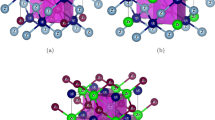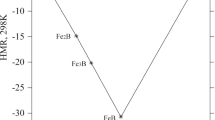Abstract
A kinetic theory of ordering based on the path probability method was implemented in the pair (Bethe) approximation and used to study the kinetics of short- and long-range ordering in alloys with equilibrium states of B2, DO3, or B32 order. The theory was developed in a superposition approximation for a vacancy mechanism on a bcc lattice with first- (1nn) and second-nearest neighbor (2nn) pair interactions. Chained 1nn conditional probabilities were used to account for the entropy of 2nn pair configurations. Monte Carlo simulations of ordering were also performed and their results compared to predictions of the pair approximation. Comparisons are also made with predictions from an earlier kinetic theory implemented in the point (Bragg-Williams) approximation. For all three calculations (point, pair, and Monte Carlo), critical temperatures for B2 and DO3 ordering are reported for different 1nn and 2nn interaction strengths. The influence of annealing temperature on the kinetic paths through the space of B2, DO3, and B32 order parameters was found to be strong when the thermodynamic preferences for the ordered states were of similar strengths. Transient states of intermediate order were also studied. A transient formation of B32 order in an AB3 alloy was found when 2nn interactions were strong, even when B32 order was neither a Richards-Allen-Cahn ground state nor a stable equilibrium state at that temperature. The formation of this transient B32 order can be argued consistently from a thermodynamic perspective. However, a second example of transient B2 order in an AB alloy with equilibrium B32 order cannot be explained by the same thermodynamic argument, and we believe that its origin is primarily kinetic.
Similar content being viewed by others
References
L. Anthony and B. Fultz, J. Mater. Res. 4, 1132 (1989).
L. Anthony and B. Fultz, J. Mater. Res. 4, 1140 (1989).
B. Fultz, J. Chem. Phys. 87, 1604 (1987).
B. Fultz, J. Chem. Phys. 88, 3227 (1988).
B. Fultz and L. Anthony, in Diffusion in High Technology Materials, edited by D. Gupta, A. D. Romig, Jr., and M. A. Dayananda (The Metallurgical Society, Warrendale, PA, 1988).
B. Fultz and L. Anthony, Philos. Mag. Lett. 59, 237 (1989).
H. Ouyang and B. Fultz, J. Appl. Phys. 66, 4752 (1989).
L. Anthony and B. Fultz, in Alloy Phase Stability and Design, edited by G. M. Stocks, D. P. Pope, and A. F. Giamei (Mater. Res. Soc. Symp. Proc. 186, Pittsburgh, PA, 1991), p. 181.
M. J. Richards and J. W. Cahn, Acta Metall. 19, 1263 (1971).
S. M. Allen and J. W. Cahn, Acta Metall. 20, 423 (1972).
Z. Q. Gao and B. Fultz, Philos. Mag. B 67, 787 (1993).
B. Fultz, Philos. Mag. B 67, 253 (1993).
R. Kikuchi, Ann. Phys. 10, 127 (1960).
R. Kikuchi, Prog. Theor. Phys. Suppl. 35, 1 (1966).
H. Sato and R. Kikuchi, Acta Metall. 24, 797 (1976).
K. Gschwend, H. Sato, and R. Kikuchi, J. Chem. Phys. 69, 5006 (1978).
It is straightforward to extend the derivation to ternary and quaternary alloys.
One of the sites on the y sublattice is the soon-to-be-occupied vacancy.
It is not necessary to work with the \(X_{i,i'}^\zeta (t,t + \vartriangle t)\) path variables in order to compute the \(X_i^\zeta (t)\) state variables. The \(X_i^\zeta (t)\) point state variables can more conveniently be obtained from the \(y_{ij}^{\zeta \eta }(t)\) pair state variables.
B. E. Warren, X-ray Diffraction (Addison-Wesley, Reading, MA, 1969), Sec. 12.3.
Since the AB (1:1) stoichiometry is not conducive to the formation of D03 order, we are able to identify the (1/2 1/2 1/2) peak with the presence of B32 order and the (100) peak with the presence of B2 order without any ambiguity.
A. G. Khachaturyan, Phys. Status Solidi B 60, 9 (1973).
D. de Fontaine, Acta Metall. 23, 553 (1975).
Author information
Authors and Affiliations
Rights and permissions
About this article
Cite this article
Anthony, L., Fultz, B. Kinetics of B2, DO3, and B32 ordering: Results from pair approximation calculations and Monte Carlo simulations. Journal of Materials Research 9, 348–356 (1994). https://doi.org/10.1557/JMR.1994.0348
Received:
Accepted:
Published:
Issue Date:
DOI: https://doi.org/10.1557/JMR.1994.0348




